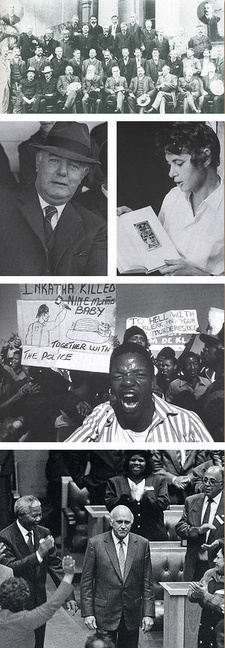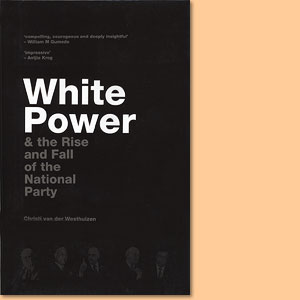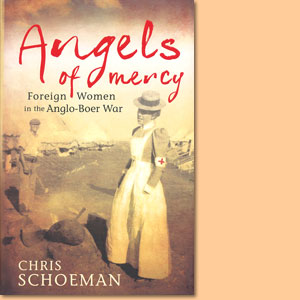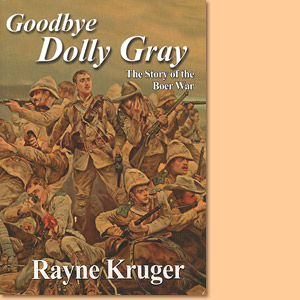White Power & the Rise and Fall of the National Party, by Christi van der Westhuizen
From Christi van der Westhuizen’s book White Power & the Rise and Fall of the National Party, this is an extract from the chapter From colonialism to apartheid.
This is what an ideology achieves. Born in a context of suffering, it elevates certain ideals to an end that, in time, begins to exert an absolute attraction for people. It subtly draws a false image of reality before their eyes, an illusion from which images of ideological opponents [are] generated. It develops its own vocabulary. It thrives on the isolation of its supporters. It interprets self-criticism as disloyalty. It scoops out ethical values and endows them with a different content. By then, the end purifies the means and little hold can be exerted on the powers that have been let loose in society. South African history tells of this - from all sides... Lubbe, Dutch Reformed Church Minister, Bloemfontein, 2001.
THE NATIONAL PARTY WAS BORN IN BLOEMFONTEIN, IN THE VERY heart of South Africa, on 7 January 1914. A day less than two years earlier, the other major nationalist contender of twentieth-century South Africa - the African National Congress - was formed in the same city. These two parties were vehicles for ideologies created partly in response to each other and to a third nationalism, which was both British and imperial. The scene was set for a struggle that would last eighty years, culminating in startling events. In 1914, General JBM (Barry) Hertzog, founder of the NP, brought together wealthy wine and fruit farmers from the Cape and lower-class Afrikaners who were struggling to eke out a living on their land, or had lost it and were trying to find their way in the cities. Lawyers, clergymen and small businessmen were also attracted to Hertzogs blend of segregation, republicanism and two-stream approach to English-speaking whites. The latter recognised that both Afrikaners and English-speaking whites had the right to express their culture separately, while coming together on issues of national importance, such as segregation. The idea was that a unified white bloc could withstand the threat of black domination.
Hertzog had advocated segregation as a permanent solution since before 1910. What horrified him was that our children will more and more feel the weight of a lower civilisation dragging them down to the level of their native environment unless they abandon the country and emigrate elsewhere or unless they suffer themselves to be completely extirpated. These words encapsulate the usual justifications for the racist policies of twentieth-century South Africa. Such was the rationale for the decisions and actions of successive governments, starting with the 1909 Convention, where an exclusive group of white men agreed on a framework for the Union of South Africa. The founding of the National Party represented the beginning of the political organisation of Afrikaner nationalism. Ethnicity and nationality gain meaning only if they are used to create awareness and mobilise people.
Collective identities are thus not given facts of life, but rather ideological constructions frequently derived from a reinvention of history to create commonalities (norms and customs; heroes). Consequently, as elites inevitably seek greater access to power and resources, they mobilise support for their claims on the basis of constructed identities. Afrikaner nationalism passed through different phases during the twentieth century. In summary, it can be described as an ideology devised to recast Afrikaans- and Dutch-speaking whites as the Afrikaner volk. The drivers behind this process were a self-conscious intelligentsia of dominees, academics, journalists, lawyers and others.
The goal: self-determination for the volk - in other words, to capture political power. Language as communicator of the common volkskultuur is integral to nationalist aspirations - thus Afrikaans was standardised and became a powerful ethnic and cultural mobiliser. A deeply conservative variant of Calvinist religion formed an essential part of the ideology, as did a mythologised history that turned the Afrikaners into Gods chosen people and the Great Trek into the equivalent of the biblical exodus from Egypt to the Promised Land. Historical events such as the nineteenth-century battle against the Zulus at Blood River and the Boers experiences in the South African War between 1899 and 1902 were loaded with nationalist symbolism.
Racism was another essential part of the ideology with which the volk was demarcated from the rest of the population on the basis of their whiteness. Fears about swart oorstroming (black swamping) and gelykstelling (equalisation) were whipped up to justify white domination. At the heart of Afrikaner nationalism sat a gender hierarchy aimed at protecting racial purity through a strictly circumscribed role for Afrikaner women. Structures such as the NP, the Broederbond and its various civil society extensions set out to imbue an imagined Afrikaner community with nationalism. The ideology was adapted over several decades by cultural, political and business elites to capture political power and, with it, control over the accumulation of wealth.
In order to do this, a cross-class cultural and racial alliance was cobbled together. Afrikaner nationalism was a response to industrialisation and urbanisation, and operated as a modernising force. The NP adapted its name several times before ensconcing itself in the pillows of state power in 1948. It went from Gesuiwerde Nasionale Party to Herenigde Nasionale of Volksparty, ending up with Hertzogs original name. These changes partly reflected the ideological battles among Afrikaner nationalists. Afrikaner nationalism ebbed and flowed as historical conditions changed and as leaders tried to elbow each other out of the way in their thirst for state power.
Mobilising white Afrikaans-speakers was no easy task. Not all Afrikaans-speaking whites were anti British imperialism, as shown by those Boers who fought on the British side in the South African War.4 While many Afrikaans-speakers shared a strong sense of patriotism, that did not necessarily make them Afrikaner nationalist. Many white Afrikaans-speakers were racist, but being Afrikaans and being racist were not synonymous. Racist rhetoric would not necessarily spur such people on in the service of Afrikaner nationalism. By no means were all white Afrikaans-speakers opposed to fighting on the British side in the two world wars.
Many Afrikaners continued to vote for the South African Party and its successors. It took several decades and many different ideologues to meld a collection of white Afrikaans-speakers into an Afrikaner community. Common enemies were identified, as well as what would constitute a regte Afrikaner (real Afrikaner). Myths were conjured up to produce a common past and destiny. Heroes were unearthed; songs were written. And all the while, Afrikaner economic advance was being driven forward. White Dutch- or Afrikaans-speaking ranks were historically disparate and without a collective consciousness. By the second half of the nineteenth century, little affinity existed between the Dutch/Afrikaans-speakers in the British-ruled Cape Colony and those of the two independent Boer republics. [...]
This is an extract from the book: White Power & the Rise and Fall of the National Party, by Christi van der Westhuizen.
Book title: White Power & the Rise and Fall of the National Party
Author: Christi van der Westhuizen
Publisher: Zebra Press
Cape Town, South Africa 2007
ISBN 9781770073050
Hardcover, 15x23 cm, 384 pages, several bw-photos
van der Westhuizen, Christi im Namibiana-Buchangebot
White Power & the Rise and Fall of the National Party
White Power & the Rise and Fall of the National Party is a well-timed study telling the story of South Africa’s past in a way that illuminates history and the present.
Weitere Buchempfehlungen
Angels of Mercy: Foreign Women in the Anglo-Boer War
Angels of Mercy tells true stories of compassion and courage of altruistic foreign women in the Anglo-Boer War.
Goodbye Dolly Gray. The Story of the Boer War
Goodbye Dolly Gray is a remarkably prescient and erudite single-volume account of the Second Boer War.




